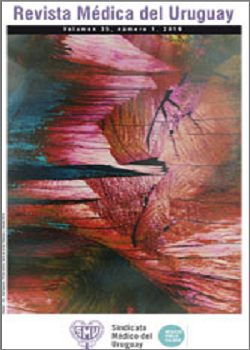Bilateral video-assisted thorascopic sympathectomy. A 10 years' experience
Abstract
Hyperhidrosis is defined as excessive sweating as a response of thermal or emotional stimuli beyond physiological requirements, and it incidence is 2 to 4% of the global population. In spite of there being several kinds of treatment, surgery provides excellent results with low relapse rates.
Method:
retrospective study of 190 video-assisted thoracic sympathectomies performed from 2003 until 2013, accounting for 95 patients. A survey was conducted through a quality-of-life questionnaire and questions on the severity of symptoms.
Results:
58 patients completed the survey (30% men and 70% women) with an average age of 25 years old. 90% were discharged from hospital between 24 and 48 hours after surgery. 72% of patients presented severe hyperhidrosis. Based on the procedure, we may state 2 patients presented recurrence and only one patient declared to be uncomfortable with the hyper-dryness of skin. 80% of patients presented some kind of compensating hyperdidrosis, being the no reason for concern among patients. There were no complications arising from the procedure. As to the quality of life it used to be bad or fair in 90% of patients, and improved in the postoperative period, being it good or very good in 95% of them. 94% of patients are satisfied or very satisfied with the procedure and its results. As a conclusion, we may sat that bilateral thoracic sympathectomy is a highly safe and effective method to treat hyperhidrosis.
References
(1) Strutton DR, Kowalski JW, Glaser DA, Stang PE. US prevalence of hyperhidrosis and impact on individuals with axillary hyperhidrosis: results from a national survey. J Am Acad Dermatol 2004; 51(2):241-8.
(2) Shargall Y, Spratt E, Zeldin RA. Hyperhidrosis: what is it and why does it occur? Thorac Surg Clin 2008; 18(2):125-32.
(3) Lin CC, Mo LR, Lee LS, Ng SM, Hwang MH. Thoracoscopic T2-sympathetic block by clipping—a better and reversible operation for treatment of hyperhidrosis palmaris: experience with 326 cases. Eur J Surg Suppl 1998; 580:13-6.
(4) de Campos JR, Kauffman P, Werebe Ede C, Andrade Filho LO, Kusniek S, Wolosker N, et al. Quality of life, before and after thoracic sympathectomy: report on 378 operated patients. Ann Thorac Surg 2003; 76(3):886-91.
(5) Baumgartner FJ, Bertin S, Konecny J. Superiority of thoracoscopic sympathectomy over medical management for the palmoplantar subset of severe hyperhidrosis. Ann Vasc Surg 2009; 23(1):1-7.
(6) Ishy A, de Campos JR, Wolosker N, Kauffman P, Tedde ML, Chiavoni CR, et al. Objective evaluation of patients with palmar hyperhidrosis submitted to two levels of sympathectomy: T3 and T4. Interact Cardiovasc Thorac Surg 2011; 12(4):545-8.
(7) Rodríguez PM, Freixinet JL, Hussein M, Valencia JM, Gil RM, Herrero J, et al. Side effects, complications and outcome of thoracoscopic sympathectomy for palmar and axillary hyperhidrosis in 406 patients. Eur J Cardiothorac Surg 2008; 34(3):514-9.
(8) Panhofer P, Naumayer C, Zacherl J, JAkesz R, Bischof G. A survey and validation guide for health-related quality-of-life status in surgical treatment of hyperhidrosis. Eur Surg 2005; 37(3):143-52.
(9) Solish N, Bertucci V, Dansereau A, Hong HC, Lynde C, Lupin M, et al. A comprehensive approach to the recognition, diagnosis, and severity-based
treatment of focal hyperhidrosis: recommendations of the Canadian Hyperhidrosis Advisory Committee. Dermatol Surg 2007; 33(8):908-23.
(10) Munia MA, Wolosker N, Kauffman P, de Campos JR, Puech-Leão P. A randomized trial of T3-T4 versus T4 sympathectomy for isolated axillary hyperhidrosis. J Vasc Surg 2007; 45(1):130-3.
(11) Kumagai K, Kawase H, Kawanishi M. Health-related quality of life after thoracoscopic sympathectomy for palmar hyperhidrosis. Ann Thorac Surg 2005; 80(2):461-6.
(12) Baumgartner FJ, Toh Y. Severe hyperhidrosis: clinical features and current thoracoscopic surgical management. Ann Thorac Surg 2003; 76(6):1878-83.
(13) Schmidt J, Bechara FG, Altmeyer P, Zirngibl H. Endoscopic thoracic sympathectomy for severe hyperhidrosis: impact of restrictive denervation on compensatory sweating. Ann Thorac Surg 2006; 81(3):1048-55.
(14) Dewey TM, Herbert MA, Hill SL, Prince SL, Mack MJ. One-year follow-up after thoracoscopic sympathectomy for hyperhidrosis: outcomes and consequences. Ann Thorac Surg 2006; 81(4):1227-32.
(15) Yazbek G, Wolosker N, de Campos JR, Kauffman P, Ishy A, Puech-Leão P. Palmar hyperhidrosis—which is the best level of denervation using video-assisted thoracoscopic sympathectomy: T2 or T3 ganglion? J Vasc Surg 2005; 42(2):281-5.
(16) Jaffer U, Weedon K, Cameron AE. Factors affecting outcome following endoscopic thoracic sympathectomy. Br J Surg 2007; 94(9):1108-12.
(17) Reisfeld R, Nguyen R, Pnini A. Endoscopic thoracic sympathectomy for hyperhidrosis: experience with both cauterization and clamping methods. Surg Laparosc Endosc Percutan Tech 2002; 12(4):255-67.
(18) Campanati A, Penna L, Guzzo T, Menotta L, Silvestri B, Lagalla G, et al. Quality-of-life assessment in patients with hyperhidrosis before and after treatment with botulinum toxin: results of an open-label study. Clin Ther 2003; 25(1):298-308.
(19) Amir M, Arish A, Weinstein Y, Pfeffer M, Levy Y. Impairment in quality of life among patients seeking surgery for hyperhidrosis (excessive sweating): preliminary results. Isr J Psychiatry Relat Sci 2000; 37(1):25-31.













